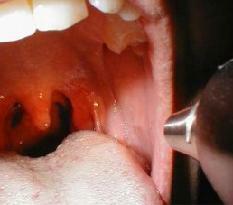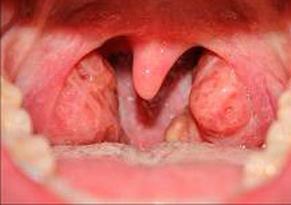 Staphylococcus in the throat is the presence of a bacterium in the mucous membrane of the pharynx or larynx, which can cause an infectious and inflammatory process. A microbe can exist there as a conditionally pathogenic microflora, that is, not causing a disease, but can cause an inflammatory reaction.
Staphylococcus in the throat is the presence of a bacterium in the mucous membrane of the pharynx or larynx, which can cause an infectious and inflammatory process. A microbe can exist there as a conditionally pathogenic microflora, that is, not causing a disease, but can cause an inflammatory reaction.
Staphylococcus aureus is considered to be the most dangerous, as it causes disease more often than other species( epidermal and saprophytic) and is the most aggressive.
People with advanced age or with weak immunity, as well as young children, are most susceptible to infection. Its carrier can be everyone, thus, it is possible even not to guess about the latent illness.
What is it?
Staphylococcus is a bacterium that belongs to the coccus family. It is quite resistant to environmental influences. On subjects, the bacterium can live up to six months. Staphylococcus can affect any organ in the human body, but most often it is located on the skin and mucous membrane in the throat and nose.
The youngest children are most susceptible to staphylococcal infection, especially after exposure to harmful factors during pregnancy and during labor( pregnancy pathology, prolonged anhydrous interval in childbirth), which are on early artificial feeding. The elderly are at risk of this infection, especially with diabetes mellitus, oncological and rheumatic diseases, eczema.
The danger of this bacterium lies in the fact that the causative agent of staphylococcus is not susceptible to antibiotics, namely to cephalosporins and penicillins. That is why the treatment of Staphylococcus aureus is much longer and more difficult than eliminating common bacteria. If you start the treatment process, it can lead to death.
Infection can occur:
- by airborne droplets;
- for non-observance of personal hygiene;
- in utero from mother to child.
If a person has staphylococcus, this can lead to chronic diseases and purulent infections. Staphylococcus has the ability to migrate through the body, and it is unlikely that it will linger in the throat, so other organs can also be affected.
Frequent complications of Staphylococcus aureus may include: meningitis, pneumonia, osteomyelitis, endocarditis and even sepsis.
Symptoms of staphylococcus in the throat of
In adults, when Staphylococcus aureus enters the mucous surface of the throat and its progression, symptoms are as follows:
- weakness;
- drowsiness;
- lack of appetite;
- sharp headache.
- inflammation of the tonsils;
- increase in the temperature threshold to 39-40 °;
- is an uncharacteristic increase in swelling of the lymph nodes;
- pain syndrome with swallowing of saliva, fluid and food;
- swelling of the mucous throat, the appearance of whitish plaque or pustular neoplasms;
In a word, all the symptoms are typical for purulent sore throat. With the only difference is that staphylococcal infection is difficult to treat with antibiotics and can migrate to other organs, including joints.

Diagnostics
Diagnostics includes carrying out a culture on the bacteria, as well as a blood sampling, with the help of which physicians detect the bacterium of staphylococcus. To determine the sensitivity of staphylococcus to antibacterial drugs, the doctor conducts an additional test.
Before treating staphylococcus in the throat, it is necessary that the individual intolerance of the components of the drug is taken into account, therefore, for each patient, a special treatment complex should be selected. Dosage is also established by the attending physician in dependence and it depends on the age and weight category.
Preventing infection with Staphylococcus aureus will help to comply with the usual rules of hygiene, the absence of severe stress, normal diet, sleep and rest, as well as the regular sanation of all chronic foci in the oral cavity and nasal passages. How to treat staphylococcus in throat
Staphylococcus aureus is very prone to high and low temperatures, as well as to sudden changes in temperature, it also constantly mutates and develops resistance to antibiotics. Therefore, when treating staphylococcus in the throat, you should immediately consult a specialist to avoid complications.
As mentioned above, when selecting drugs, it should be taken into account that Staphylococcus aureus is extremely resistant to the use of antibiotics - the microorganism produces enzymes that destroy them. Therefore, in order to cure this infection, antibacterial drugs of a new generation are used, among them:
- Semisynthetic and protected penicillins( "Amoxiclav", "Nacillin");
- Aminoglycosides( "Neomycin", "Kanamycin");
- Others( "Vancomycin", "Tetracycline", "Clindamycin", "Rifaximin", "Oflocacin").
Due to the fact that taking antibiotics can cause dysbacteriosis, some doctors can prescribe an additional intake of drugs that will help normalize the intestinal microflora.
In case of ineffectiveness or impossibility of carrying out antibacterial therapy, patients are assigned a staphylococcal bacteriophage, which, in fact, is a bacterial virus. Its advantages are that it affects only certain pathogenic microorganisms without damaging the normal microflora, has no contraindications and side effects.
Symptomatic treatment in adults with the development of purulent process in the oropharynx as a result of exposure to Staphylococcus aureus is the same as in angina. People's means should not be carried away, they must complement the basic treatment.

Treatment of staphylococcal carrier
Than to treat? To eliminate the carriage of Staphylococcus aureus, you can use the following scheme:
- Staphylococcal bacteriophage 3 to 5 ml in each nostril twice a day for 7 days.
- IRS-19 at a dose in each nostril 2 times a day for a month.
- Bronchomunal 7 mg in the morning for 10 days, only 3 courses with an interval of 20 days.
A month after the end of such treatment, it is necessary to pass a control culture on the microflora.

How to choose probiotics for the intestines: a list of drugs.

Effective and inexpensive cough syrups for children and adults.

Modern non-steroidal anti-inflammatory drugs.

Review of tablets from the increased pressure of the new generation.
 Antiviral drugs are inexpensive and effective.
Antiviral drugs are inexpensive and effective.
